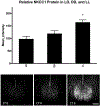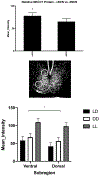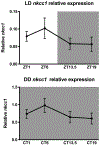The Excitatory Effects of GABA within the Suprachiasmatic Nucleus: Regulation of Na-K-2Cl Cotransporters (NKCCs) by Environmental Lighting Conditions
- PMID: 32406304
- PMCID: PMC8060922
- DOI: 10.1177/0748730420924271
The Excitatory Effects of GABA within the Suprachiasmatic Nucleus: Regulation of Na-K-2Cl Cotransporters (NKCCs) by Environmental Lighting Conditions
Abstract
The suprachiasmatic nucleus (SCN) contains a pacemaker that generates circadian rhythms and entrains them with the 24-h light-dark cycle (LD). The SCN is composed of 16,000 to 20,000 heterogeneous neurons in bilaterally paired nuclei. γ-amino butyric acid (GABA) is the primary neurochemical signal within the SCN and plays a key role in regulating circadian function. While GABA is the primary inhibitory neurotransmitter in the brain, there is now evidence that GABA can also exert excitatory effects in the adult brain. Cation chloride cotransporters determine the effects of GABA on chloride equilibrium, thereby determining whether GABA produces hyperpolarizing or depolarizing actions following activation of GABAA receptors. The activity of Na-K-2Cl cotransporter1 (NKCC1), the most prevalent chloride influx cotransporter isoform in the brain, plays a critical role in determining whether GABA has depolarizing effects. In the present study, we tested the hypothesis that NKCC1 protein expression in the SCN is regulated by environmental lighting and displays daily and circadian changes in the intact circadian system of the Syrian hamster. In hamsters housed in constant light (LL), the overall NKCC1 immunoreactivity (NKCC1-ir) in the SCN was significantly greater than in hamsters housed in LD or constant darkness (DD), although NKCC1 protein levels in the SCN were not different between hamsters housed in LD and DD. In hamsters housed in LD cycles, no differences in NKCC1-ir within the SCN were observed over the 24-h cycle. NKCC1 protein in the SCN was found to vary significantly over the circadian cycle in hamsters housed in free-running conditions. Overall, NKCC1 protein was greater in the ventral SCN than in the dorsal SCN, although no significant differences were observed across lighting conditions or time of day in either subregion. These data support the hypothesis that NKCC1 protein expression can be regulated by environmental lighting and circadian mechanisms within the SCN.
Keywords: GABAA receptors; chloride; circadian; entrainment; phase shifting.
Conflict of interest statement
CONFLICT OF INTEREST STATEMENT
The authors have no potential conflicts of interest with respect to the research, authorship, and/or publication of this article.
Figures






Similar articles
-
Functional Significance of the Excitatory Effects of GABA in the Suprachiasmatic Nucleus.J Biol Rhythms. 2018 Aug;33(4):376-387. doi: 10.1177/0748730418782820. Epub 2018 Jul 5. J Biol Rhythms. 2018. PMID: 29974800 Free PMC article.
-
Circadian rhythm of AMPA receptor GluR2/3 subunit-immunoreactivity in the suprachiasmatic nuclei of Syrian hamster and effect of a light-dark cycle.Brain Res. 1999 Jun 26;833(1):27-38. doi: 10.1016/s0006-8993(99)01460-2. Brain Res. 1999. PMID: 10375674
-
Regulation of the phase and period of circadian rhythms restored by suprachiasmatic transplants.J Biol Rhythms. 1996 Jun;11(2):145-62. doi: 10.1177/074873049601100207. J Biol Rhythms. 1996. PMID: 8744242
-
Role of GABA in the regulation of the central circadian clock of the suprachiasmatic nucleus.J Physiol Sci. 2018 Jul;68(4):333-343. doi: 10.1007/s12576-018-0604-x. Epub 2018 Mar 20. J Physiol Sci. 2018. PMID: 29560549 Free PMC article. Review.
-
The dynamics of GABA signaling: Revelations from the circadian pacemaker in the suprachiasmatic nucleus.Front Neuroendocrinol. 2017 Jan;44:35-82. doi: 10.1016/j.yfrne.2016.11.003. Epub 2016 Nov 25. Front Neuroendocrinol. 2017. PMID: 27894927 Free PMC article. Review.
Cited by
-
Circadian Rhythm Regulation by Pacemaker Neuron Chloride Oscillation in Flies.Physiology (Bethesda). 2024 May 1;39(3):0. doi: 10.1152/physiol.00006.2024. Epub 2024 Feb 27. Physiology (Bethesda). 2024. PMID: 38411570 Free PMC article. Review.
-
Systematic review of drugs that modify the circadian system's phase-shifting responses to light exposure.Neuropsychopharmacology. 2022 Mar;47(4):866-879. doi: 10.1038/s41386-021-01251-8. Epub 2021 Dec 27. Neuropsychopharmacology. 2022. PMID: 34961774 Free PMC article.
-
Physiological Processes Modulated by the Chloride-Sensitive WNK-SPAK/OSR1 Kinase Signaling Pathway and the Cation-Coupled Chloride Cotransporters.Front Physiol. 2020 Oct 20;11:585907. doi: 10.3389/fphys.2020.585907. eCollection 2020. Front Physiol. 2020. PMID: 33192599 Free PMC article. Review.
-
Aging affects GABAergic function and calcium homeostasis in the mammalian central clock.Front Neurosci. 2023 May 16;17:1178457. doi: 10.3389/fnins.2023.1178457. eCollection 2023. Front Neurosci. 2023. PMID: 37260848 Free PMC article.
-
Modelling the functional roles of synaptic and extra-synaptic γ-aminobutyric acid receptor dynamics in circadian timekeeping.J R Soc Interface. 2021 Sep;18(182):20210454. doi: 10.1098/rsif.2021.0454. Epub 2021 Sep 15. J R Soc Interface. 2021. PMID: 34520693 Free PMC article.
References
-
- Albus H, Vansteensel M, Michel S, Block G, and Meijer J (2005) A GABAergic mechanism is necessary for coupling dissociable ventral and dorsal regional oscillators within the circadian clock. Curr Biol 15:886–893. - PubMed
-
- Alessi DR, Zhang J, Khanna A, Hochdorfer T, Shang Y, and Kahle KT (2014) The WNK-SPAK/OSR1 pathway: master regulator of cation-chloride cotransporters. Sci Signal 7:re3. - PubMed
Publication types
MeSH terms
Substances
Grants and funding
LinkOut - more resources
Full Text Sources
Research Materials

